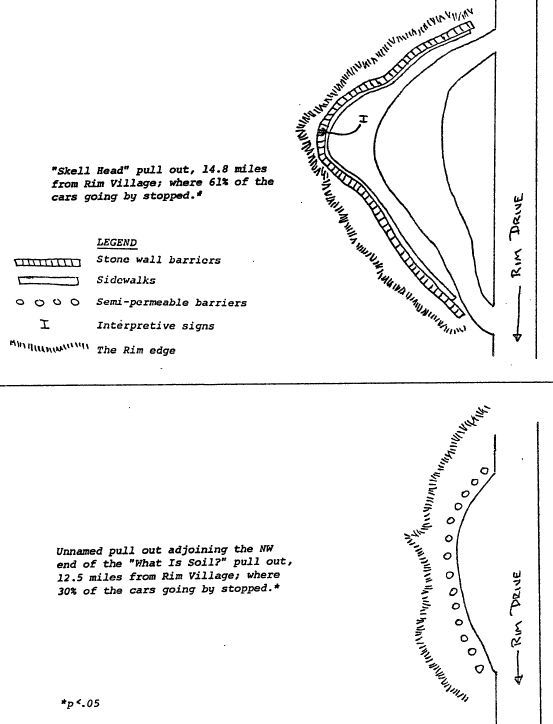Degree of Development
The overall level of development combines the four preceeding factors. It differentiates a site that has had much work put into it from a relatively undeveloped site. The “Skell Head” pull out is separated from the road, has low stone walls, sidewalks, a large parking area (15 to 20 cars), interpretive signing, and an excellent view of the Lake (see Figure 8). This site contrasts in every respect except quality of view with the undeveloped area adjoining the northwest end of the “What Is Soil?” pull out. The latter site has noi, solid barrier but instead wooden reflector posts for traffic safety, no paving, no sidewalks, a medium-sized parking area (10 to 15 cars), and no interpretive signing. Like the Skell Head site, this pull out offers a spectacular view of the Lake. At the more developed “Skell Head” pull out 61% of the cars stop, while less than half as mahy (30%) stop at the undeveloped, unnamed site (p<.05).
Implications for Management
The developments discussed in the preceeding sections are essentially “cues” which tell visitors that the site is important to managers of the area. At sites that a manager particularly wants visitors to see, structures can be manipulated to increase the probability that visitors will stop. A large parking area, separation from the road, a good view of the lake, and obviously placed interpretive signs are all factors which attract visitors. The overall level of development also indicates that a site is relatively important. Conversely, visitors can be directed away from sites that are fragile or dangerous by “cues” which indicate that the site is unimportant.
Figure 8. Degree of development.
GETTING THE VISITOR OUT OF THE CAR
We identified two factors that may have an effect on how many visitors got out of their cars once they had stopped. These factors are a better view from outside of the car and an attraction such as an interpretive sign that can only be read from outside the car. At each site we recorded the percentage of groups in which at least one person got out of the car.
Better View From Outside
Once visitors have stopped at a pull out, the possibility of a better view from outside the car may entice them out. Figure 9 shows two sites that are similar except for the view available from outside the car. The “Cleetwood Flow” pull out offers a good view of the interpretive sign and the Lake from inside the car, but by stepping out a more spectacular view is available. At this site someone got out of the car 69% of the time.
At the “Red Cloud Cliff and Pumice Castle” pull out, the rock formations and the interpretive sign can be seen from inside the car. In addition, the caldera walls slope so that even getting out there is no point where the visitor can find the spectacular view offered at the “Cleetwood Flow” pull out. Consequently only 53% of the visitors leave the car at this site (p<.02).


